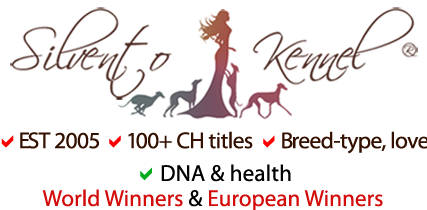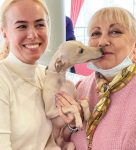Mrs. Leona Dams Reyneart has been breeding Italian Greyhounds since 1979 with the suffix “of Devils Pigeons” in Belgium. She got involved in the sighthound breeds buying an Afghan Hound from the famous Von Oranje Manege kennel, of the late Mrs Eta Pauptit, the a Whippet of English origins and eventually the Italian Greyhound became her passion and in so many years of breeding gave her a lot of gratifications by winning important titles at the main dog related events. Frequently going to the dog shows Mrs Dams thought it right to become a judge too and now she is licensed to judge at international level all the Sighthounds, the English sheepdogs, the Staffordshire bull terrier and the American Staffordshire terrier.
How long have you been breeding IG?
I had my first litter in 1979.
Who was your very first specimen of the breed?
My first IG was Myrthe des Pitchoun Diables, daughter of Ch Lutin des Pitchoun Diables and granddaughter of Cupido Springinsfeld. I showed her and she became International, Belgian, Dutch, Lux. and German Champion. Myrthe and Olimpe des Pitchoun Diables were the foundations bitches of my kennel.
Of all the IGs you have owned or bred who was the closest to your ideal?
This is a difficult question because I have own preferred type of dogs who look very much alike. I don’t think this type has changed during the thirty and plus years of my breeding. It is impossible to produce perfect dogs and I don’t mind if anyone should prefer another type, because these are the dogs that I like to produce. I must admit that I find my dogs a little better than my bitches but if someone would ask me to make a choice between my males it wouldn’t be possible. Even if my bitches were a little bit flashier I’d need their soundness too in order to give me beautiful litters.
How a perfect IG, in your opinion, should look like?
Elegant, with a nice long head, fine ears, able to move like a real sighthound should do.
What are the main problems in the breed today?
I must say that IG have improved a great deal over the years, they have sounder movement and you don’t see the tiny, fragile little dogs so common in the past. Of course there are still small problems but our breed does not have too many health problems in comparison to other breeds and it is possible to avoid them.
So, you don’t think it is time now to carry out of the current IG’s standard for any other aspect too?
Why should we change the standard of a breed that has never changed for centuries? The standard is clear and very complete about everything. Perhaps it could be a little more specific about the gait, that is a peculiar trait of the IG.
Do you think the breed has changed negatively or has improved during these past decades?
As I said before I think the breed has improved a great deal, possibly because it is easier to use the best dogs from all over Europe. We have the possibility to find on the internet suitable males or females to use in our breeding programmes. Also distance is no longer a problem, we can go to every place we like or, if this no possible, we can use frozen or fresh semen from everywhere.
At the shows can be seen IGs moving with different side gait, some with more extention and some with a more restricted or very springy stride. Are they all correct?
In my opinion the typical movement of an IG, as for every sighthound, should let the dog cover a lot of ground but not straight forward like Whippet, but both a light bending of the pastern and certainly not high stepping. As present you can see more IGs presented in the ring with an overly straight movement. We must put attention on this.
The IG has spread all over the world. Do you think there is a diversion between European, American and other countries types?
I certainly think that there is a big difference between the American and European IGs. I am afraid it is not only the colour but American IGs look more like small Whippets and missing one or more premolar is not considered a big problem providing the bite is correct. The European standard, instead, requires a complete scissor bite.
In your opinion a great winning bitch in the ring can also be a good brood bitch?
It is possible but has never happened as far I am concerned. My best bitch has never been my best brood bitch. Perhaps her sister that has never been such a big winner could give better litters. A good brood bitch with a good pedigree is a must: it is no possible to produce litters of high quality without her.
In your opinion what is the best age to choose a future show prospect up?
I prefer to choose the puppy at birth and I don’t change my mind during the following weeks. The most beautiful puppy could be a disaster from six to nine month old, at that time I always have many doubts but, eventually, it turns out I had done the right choice. Only in one of my litters, the one sired by Ah! Lutin des Pitchoun Diables, I was very confused because all the five male puppies were so even in quality that it was impossible to take a decision, even after eight weeks. I think now that really it would have been of no importance which male I would choose to keep, because after two years there is not yet a big difference among them.
Could you say something on your experience as a judge?
IGs are not my favourite breed to judge, I know them too well. I know what to expect and know the dogs perfectly when judging around my country. But there are exceptions: when some years ago I was judging IG in Germany, I was pleasantly surprised when I saw in my ring Ch. Kafiristans Fidelio, my Bobby’s (Dynastie Durrani’s Yehudiblue) father. He was entered at his first show. I thought: “where does this magnificent dog come from?” And he became my best of Breed. That was the start to his successful show career.
How important is handling in the IG rings?
As for every other breed it is very important. How is possible for a judge recognize the best dog if it does not want to show? How is possible to judge a dog if he doesn’t want to be touched and see a good movement when the dog does not show itself?
Lately IGs have become to be handled like Whippets. Do you think it is the correct way to show such a lively breed?
May be it is one of the most difficult breed to show because they are so lively, they don’t want to please their owners all the time but, if they are well socialized and you have nerves of steel, it is possible to teach them, in a gentle but firm way, to do what they need to show themselves well in the ring. In my house they can play all week long and I ask them only for ten minutes of their attention in the ring.
If I look around, most of the IG people stand around the ring with their dog in their arms, as if he were their favourite doll. It is better, for their temperament, to let an IG be a real independent dog. The dog likes it and he will have a lot more confidence in the ring.
Are racing and lure cursing a common practice for IG in your country?
Yes, some breeders only breed for the race track or cure coursing. This is also dangerous, because they don’t mind the breed standard, only the speed. Our Belgian Kennel Club, however, is trying to put a stop to this problem, because from this year on every dog has to take part at least at one dog show before being able to be used for breeding.
Could you briefly explain how dog shows are organized in your country?
To become a Belgian Champion you have to win 4 CAC (two of them on International level shows). If the winning dog is already a Belgian Champion, the CAC goes to reserve CAC. You can start to get your CACs in the open class, from 15 month of age and there must be one year and a day between the first and the last CAC. Of course the dog can be judged by a minimum of three different judges.
Is there anything I have forgotten in my questionnaire that you would like to talk about?
I hope all breeders continue to breed like they have been so far, not producing only money but trying and improve the IG. I also hope we can continue to have the good collaboration among us in the future.
This article was provided by Julia Paju
Journal Bollettino (12/2009)



